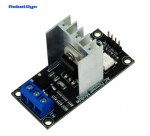So having some problems getting this to work. I have been using MOC3041 along with a 4 amp Triac to control basic on/off or flashing/ strobing an AC lamp but thought using the zero-cross opto-coupler would be able to work with the MOC3041 but it flashes instead of ramping up and down. I even tried using a "pre-built" circuit but with the same outcome. The only thing I am not sure of is the pre-built has 4 connections +, -, signal (PWM) and a forth marked Z/C. Can someone shed some "light" on what I may be doing wrong?
Dave

Dave

